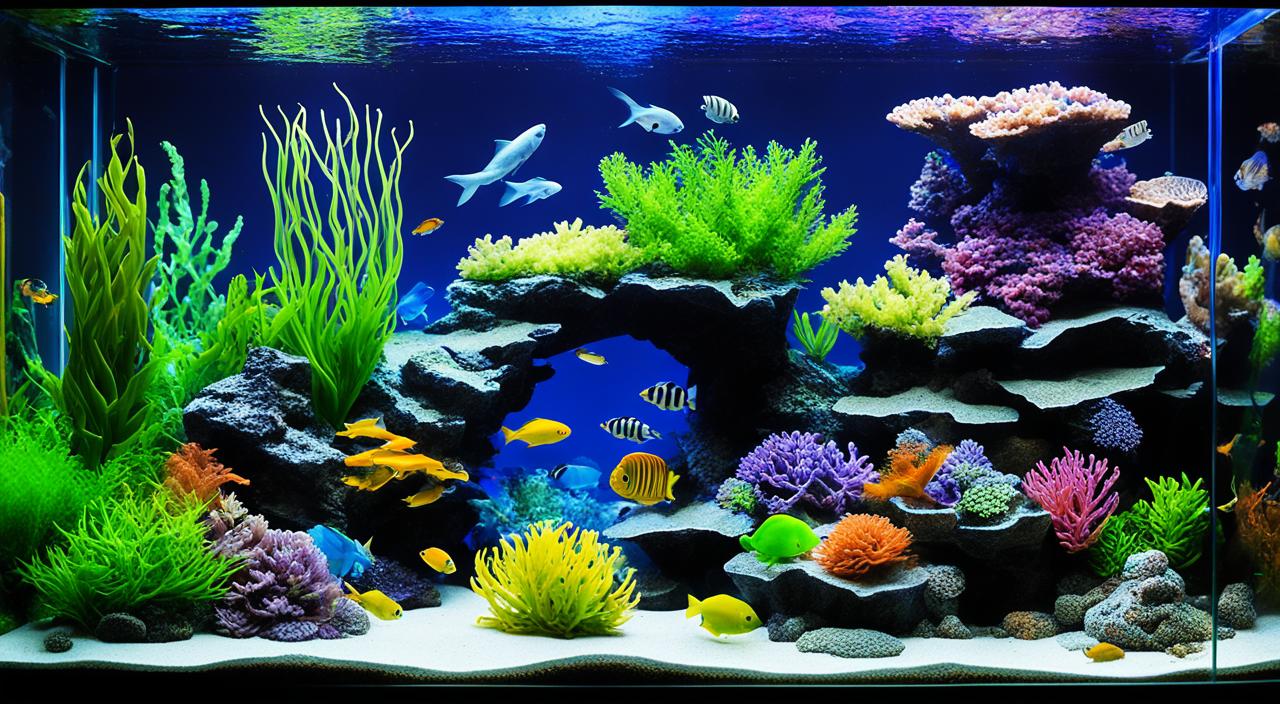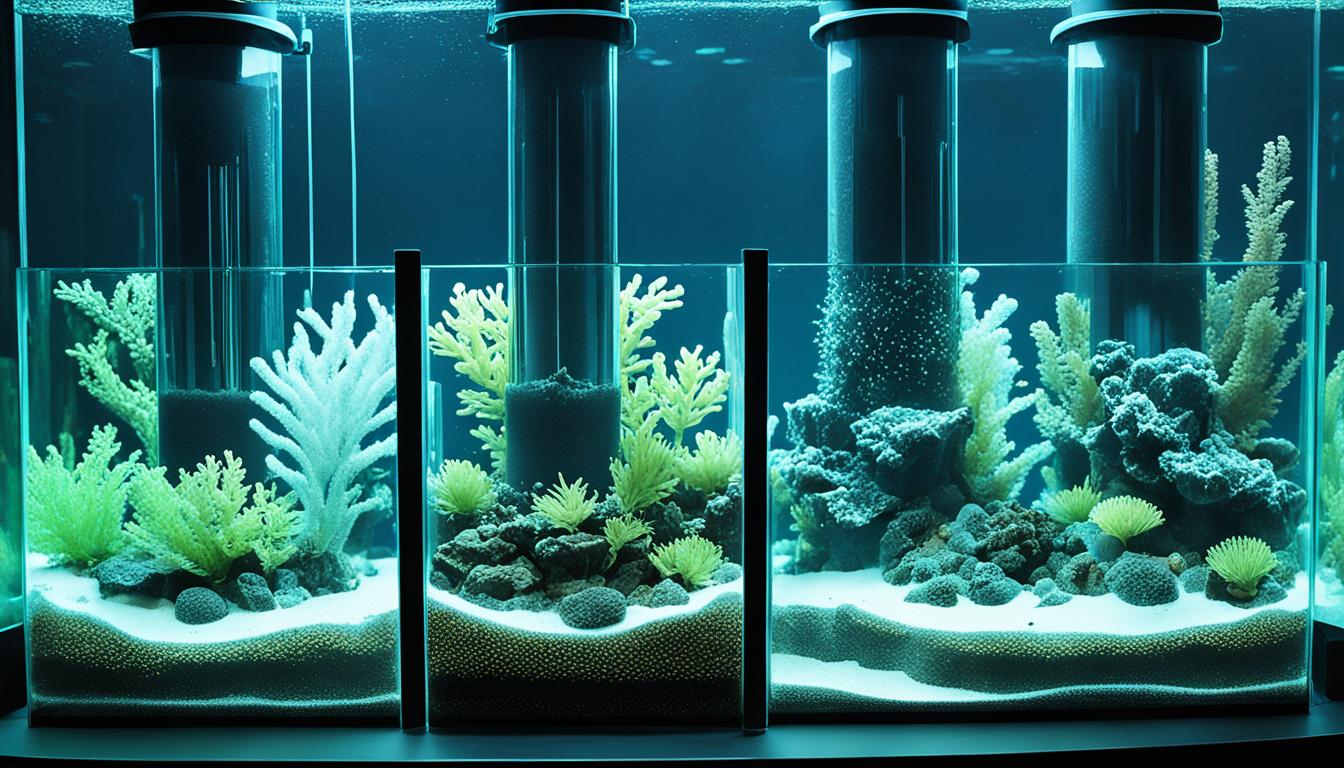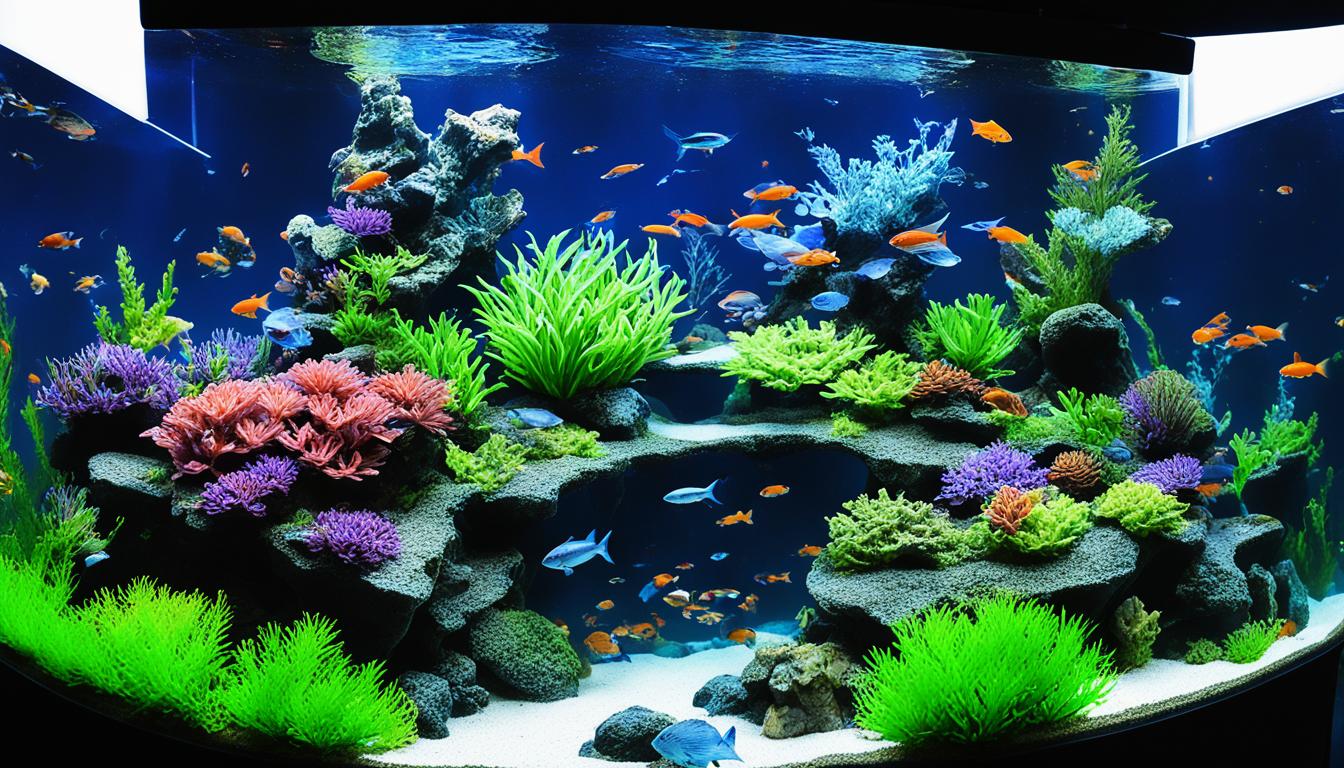Welcome to our comprehensive guide on aquarium filter types! Proper filtration is essential for maintaining a healthy and thriving aquatic environment. This article will explore the different kinds of aquarium filters, their functions, and how to choose the right one for your aquarium.
Whether you’re a seasoned aquarium enthusiast or just starting, understanding the importance of aquarium filtration and the available options will help you provide the best care for your aquatic pets. Let’s dive in and explore the fascinating world of aquarium filters!
Key Takeaways:
- An aquarium filter is crucial for maintaining a healthy tank and ensuring the well-being of your aquatic pets.
- Various types of aquarium filters are available, each with its own function and benefits.
- Understanding the different filter options can help you make an informed decision about the right filter for your aquarium.
- Proper filtration helps remove impurities, maintain water clarity, and provide a balanced aquatic ecosystem.
- Stay tuned as we explore each type of aquarium filter in more detail and learn how they work!
- Aquarium Filters Types: An Overview
- Understanding the Function of Aquarium Filters
- Internal versus External Filters: Pros and Cons
- The Silent Workhorses: Sponge and Air-driven Filters
- Maximizing Efficiency with Canister Filters
- Innovative Filtration Methods: Fluidized Bed Filters
- Power Filters: High-Performance Filtration for Busier Tanks
- Integrating Undergravel Filters in Aquatic Ecosystems
- FAQ
- Source Links
Aquarium Filters Types: An Overview
When maintaining a healthy aquarium, choosing the right filter is crucial. With various filter options available, deciding which one is best for your setup can be overwhelming. This section will provide an in-depth overview of the different types of aquarium filters, helping you make an informed decision based on your specific needs. Let’s dive in!
1. Internal Filters:
Internal filters are compact and versatile, designed to be placed inside the aquarium. They are suitable for small to medium-sized tanks and provide mechanical and biological filtration. Internal filters are easy to install and maintain, making them a popular choice for beginners.
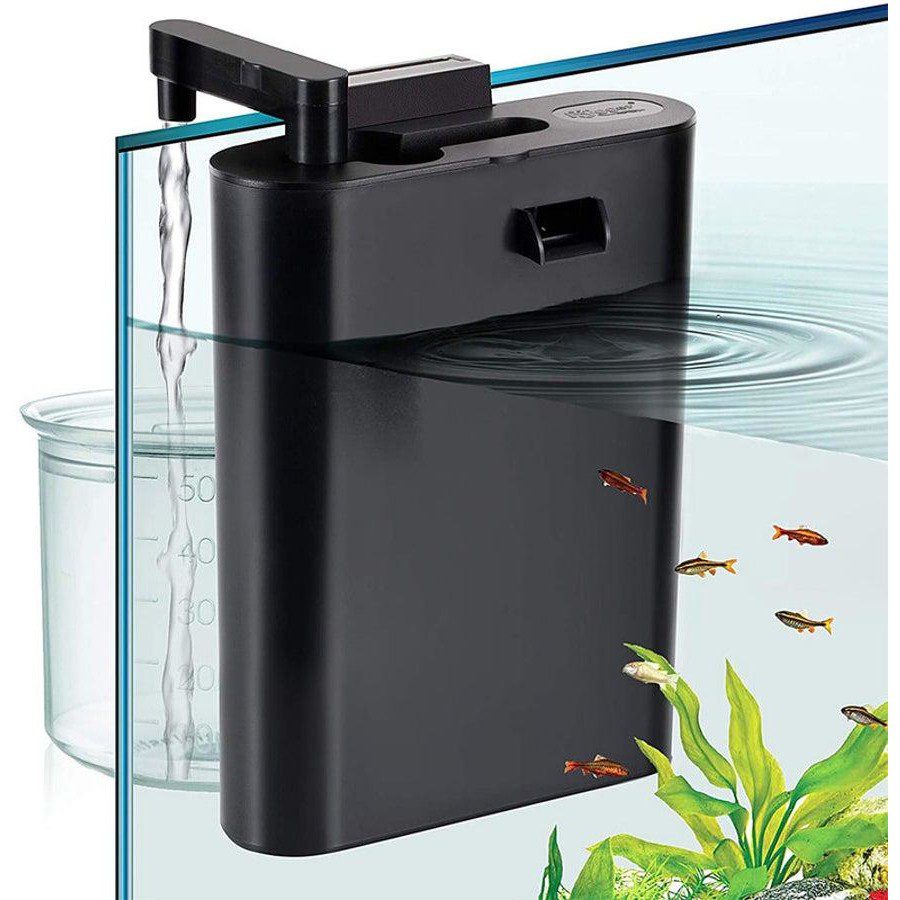
2. External Filters:
External filters, also known as canister filters, are placed outside the aquarium and are suitable for larger tanks. They offer efficient mechanical, biological, and chemical filtration. External filters are known for their high flow rate and large filter media capacity, making them ideal for tanks with higher stocking levels.
3. Power Filters:
Power filters, called hang-on-back filters, are easy to install and operate. They hang on the back of the aquarium and provide mechanical and biological filtration. Power filters are compact, affordable, and suitable for tanks of various sizes.
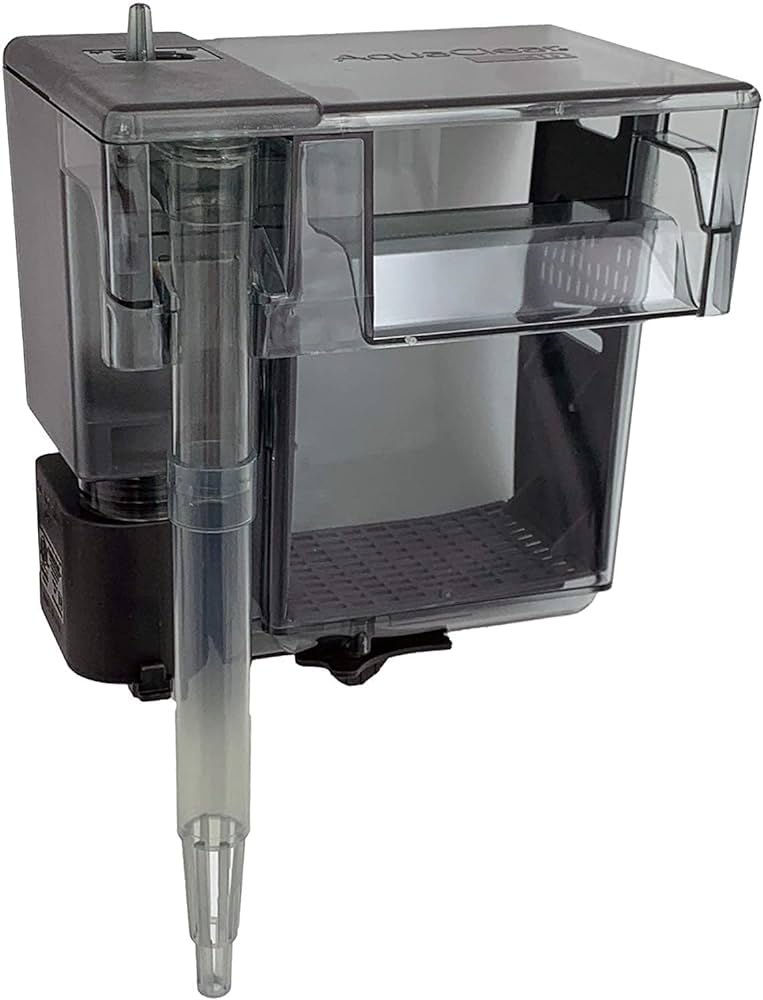
4. Sponge Filters:
Sponge filters are simple and budget-friendly options for aquarium filtration. They consist of a sponge attached to an air pump, which creates a gentle water flow. Sponge filters provide mechanical and biological filtration, ideal for breeding tanks and tanks with delicate or small-sized fish.
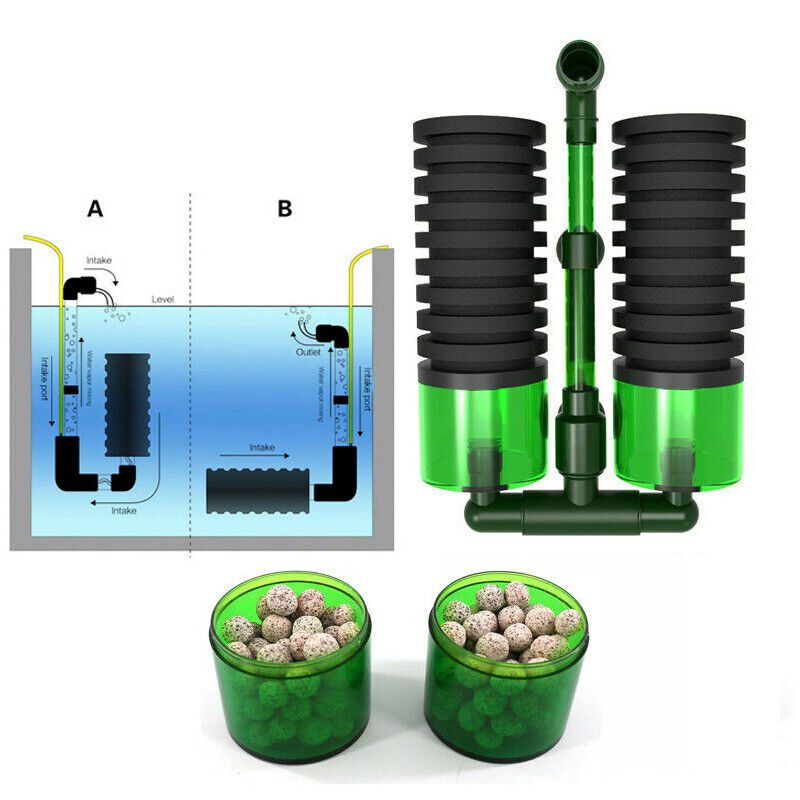
5. Canister Filters:
Canister filters are known for their high filtration capacity and versatility. They offer mechanical, biological, and chemical filtration, ensuring optimal water quality. Canister filters are suitable for large tanks and tanks with specialized requirements.
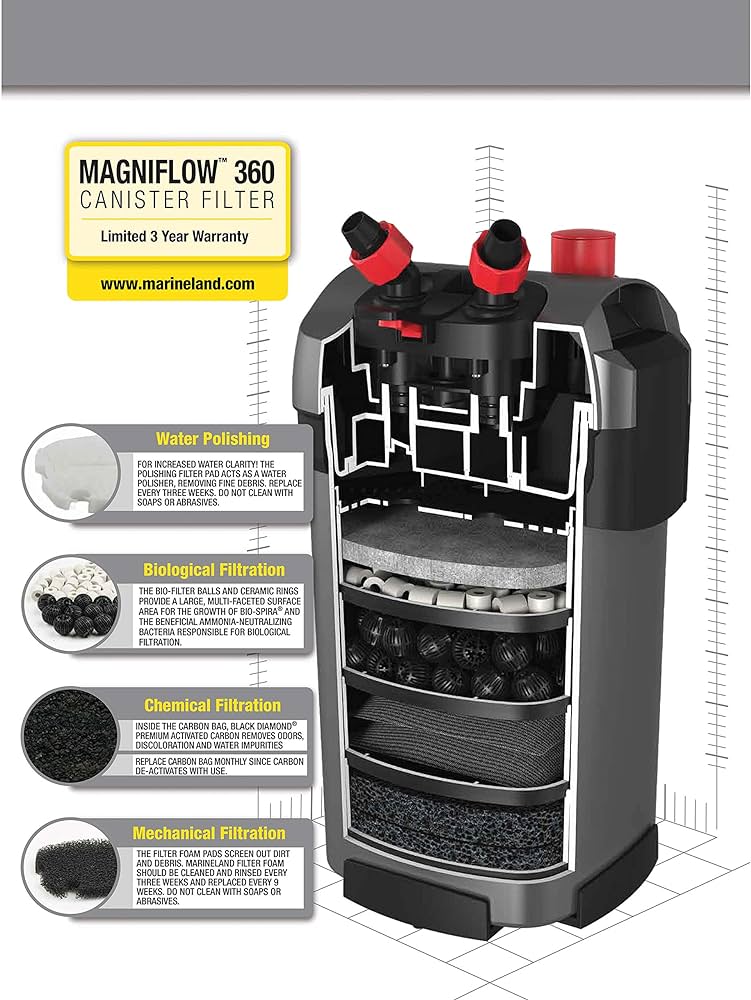
6. Undergravel Filters:
Undergravel filters consist of a plate covered with gravel at the bottom of the tank. They provide biological and mechanical filtration using the gravel bed as a filter medium. Undergravel filters are simple and cost-effective options, but they may not be suitable for all aquarium setups.
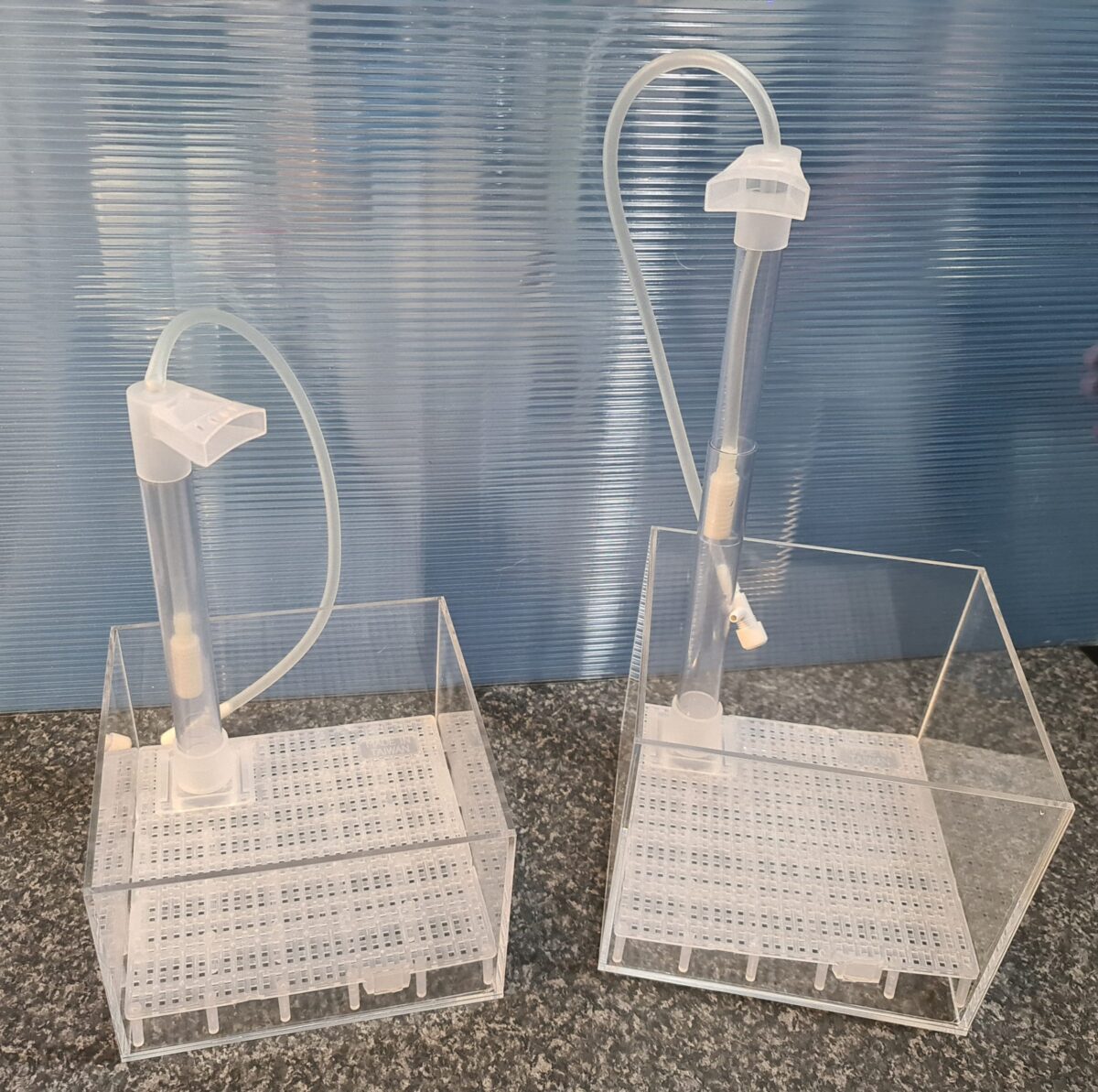
Now that you have a comprehensive overview of the different types of aquarium filters, you can make an informed decision based on your specific needs and the requirements of your aquarium. In the next section, we will explore the function of aquarium filters in detail, helping you understand how they contribute to maintaining a healthy aquatic environment.
Understanding the Function of Aquarium Filters
In this section, we will delve deeper into the function of aquarium filters. Aquarium filters are crucial in maintaining a healthy and balanced aquatic environment for your fish and other tank inhabitants. Let’s explore the three primary functions of aquarium filters: mechanical filtration, biological filtration, and chemical filtration.
Principles of Mechanical Filtration
Mechanical filtration is the first line of defence in aquarium filters. This process involves removing solid particles from the water, such as uneaten food, fish waste, and plant debris. Through various filter media, such as sponges, floss, and filter pads, aquarium filters physically trap and retain these particles, ensuring cleaner and clearer water. Mechanical filtration helps prevent clogs in the filter system, maintain water clarity, and minimize the risk of harmful substances accumulating in the tank.
The Role of Biological Filtration
Biological filtration is a vital function that relies on beneficial bacteria to convert toxic waste, particularly ammonia and nitrites, into less harmful nitrates. These beneficial bacteria colonize the filter media, creating a biological filter bed to break down organic waste. This process is essential for maintaining water quality and providing a healthy environment for your aquarium’s inhabitants. Biological filtration establishes a natural nitrogen cycle, keeping ammonia and nitrite levels low and promoting the overall well-being of your aquatic pets.
Chemical Filtration and Its Selective Nature
Chemical filtration is the final stage of aquarium filtration, where chemical filter media remove impurities and toxins from the water. Unlike mechanical and biological filtration, which focuses on physical and biological processes, chemical filtration works through adsorption, ion exchange, or chemical reactions to remove specific substances. Activated carbon and chemical resins are commonly used in aquarium filters to target substances like dissolved organics, heavy metals, and medications. Chemical filtration helps to improve water clarity, remove odours, and maintain optimal water conditions for your fish and plants.
| Filtration Type | Main Function | Filter Media Examples |
|---|---|---|
| Mechanical Filtration | Removal of solid particles | Sponges, filter pads, floss |
| Biological Filtration | Conversion of toxic waste | Bio-media, ceramic rings |
| Chemical Filtration | Removal of impurities | Activated carbon, chemical resins |
Internal versus External Filters: Pros and Cons
Two popular options for aquarium filtration are internal filters and external filters. Each type has advantages and disadvantages, and understanding the differences can help you make an informed decision about your aquarium.
Internal Filters
Internal filters are compact and designed to be submerged inside the aquarium. They are usually placed in the corner of the tank and provide mechanical, biological, and chemical filtration. These filters are easy to install and maintain, making them popular for smaller aquariums or tanks with limited space.
Pros of Internal Filters:
- Easy installation and setup
- Space-saving design
- Provides mechanical, biological, and chemical filtration
- Effective at removing debris and impurities
Cons of Internal Filters:
- It may take up valuable swimming space for fish.
- It may require more frequent cleaning due to limited filter media capacity.
- Can cause water flow disruptions and dead spots in larger tanks
External Filters
External filters are positioned outside the aquarium and connected to the tank with hoses. They are larger and offer more filter media capacity, allowing for better filtration in larger tanks. External filters are known for their efficiency and can handle higher amounts of water flow.
Pros of External Filters:
- Higher filter media capacity for better filtration
- Efficient and suitable for larger tanks
- Provides mechanical, biological, and chemical filtration
- Less frequent maintenance compared to internal filters
Cons of External Filters:
- Requires more space outside the aquarium
- Complex installation and setup
- Requires additional hoses and fittings
- Generally more expensive than internal filters
| Internal Filters | External Filters | |
|---|---|---|
| Installation | Easy, submerge in the aquarium | Requires space outside the aquarium, additional hoses |
| Filter Media Capacity | Limited, may require more frequent cleaning | Higher capacity, better for larger tanks |
| Water Flow | Potential disruptions and dead spots in larger tanks | Efficient and suitable for higher water flow rates |
| Maintenance | More frequent cleaning due to limited capacity | Less frequent maintenance compared to internal filters |
| Space Requirement | Compact, doesn’t take up space outside the tank | Requires space outside the aquarium |
| Price | Generally more affordable | Generally more expensive |
The Silent Workhorses: Sponge and Air-driven Filters
Regarding efficient and quiet filtration systems, sponge and air-driven filters are the unsung heroes of the aquarium world. These filters offer a range of benefits, making them an excellent choice for both experienced aquarists and beginners.
Maintaining Optimal Flow in Sponge Filters
Sponge filters are known for their simplicity and effectiveness. Their unique design allows for mechanical and biological filtration, making them a versatile option for aquariums of all sizes.
Regular maintenance is crucial to ensure optimal flow in sponge filters. This involves cleaning the sponge regularly to remove any debris or waste that may clog the filter. Additionally, it is crucial to monitor the water flow and adjust the air pump accordingly to maintain the desired flow rate.
Sponge filters are particularly beneficial for aquariums with delicate or slow-swimming fish species that may become stressed by strong currents. The sponge material provides a gentle filtration process without disturbing the fish or their environment.
The Simplicity of Air-driven Filters for Beginners
If you are new to aquarium keeping, air-driven filters are an excellent option to consider. These filters rely on air pumps to drive water flow, making them simple to install and maintain.
Air-driven filters’ beginner-friendly nature is further enhanced by their affordability. They are typically more budget-friendly than other filtration options, making them accessible to hobbyists who are just starting out.
In addition, air-driven filters provide aeration, which is crucial for maintaining optimal oxygen levels in the aquarium. The air bubbles created during filtration help to oxygenate the water, promoting a healthy and thriving aquatic ecosystem.
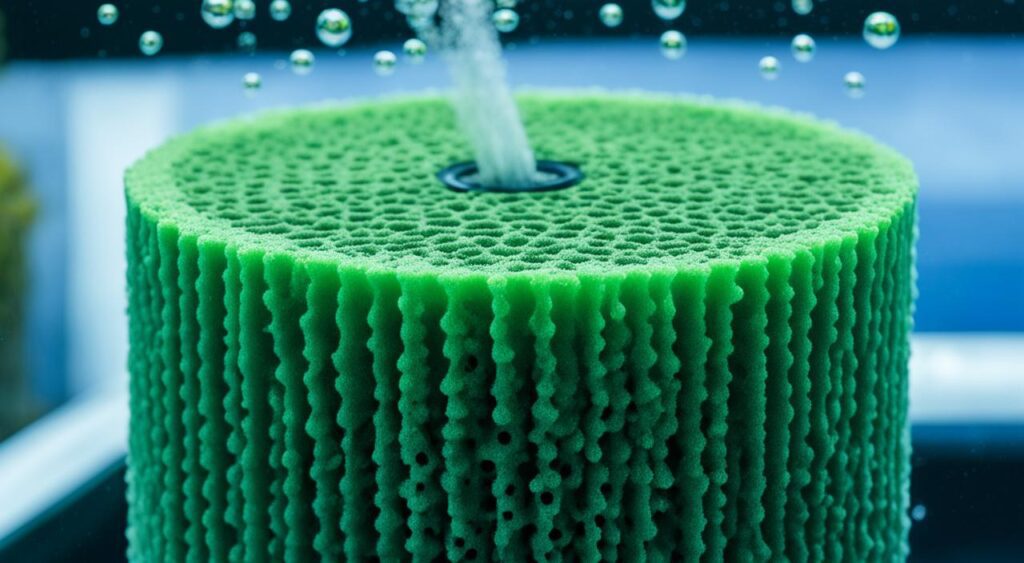
Sponge and air-driven filters offer efficient filtration with minimal noise and hassle. Whether you prefer a sponge filter’s versatility or an air-driven filter’s simplicity, both options provide a reliable and effective means of maintaining a clean and healthy aquarium environment.
Maximizing Efficiency with Canister Filters
Canister filters are popular among aquarium enthusiasts due to their exceptional filtration efficiency. They utilize a layered filtration system that enables elevated water purity, creating a healthy and thriving aquatic environment for fish and plants.
The layered filtration system of canister filters consists of multiple media compartments, each designed to target specific impurities and pollutants in the water. This comprehensive approach ensures thorough filtration, creating crystal-clear water free from debris, harmful chemicals, and excess nutrients.
One key advantage of canister filters is their versatility. They can accommodate a wide range of filter media, including mechanical, biological, and chemical filtration components. This flexibility allows you to customize your filter setup according to your aquarium’s specific needs, further enhancing its filtration capabilities.
Regular maintenance is essential to maintain your canister filter’s optimal performance. This includes cleaning and replacing filter media as needed, monitoring water flow rates, and conducting routine checks to ensure the proper functioning of the filter. By adhering to a maintenance schedule, you can prevent clogging and guarantee that your canister filter operates at its peak performance.
Canister filters offer unrivalled filtration efficiency and can be valuable to your aquarium setup. With their layered filtration system and proper maintenance, these filters provide the ideal environment for your aquatic pets to thrive.
Innovative Filtration Methods: Fluidized Bed Filters
As aquarium enthusiasts continue to seek advanced filtration techniques, fluidized bed filters have emerged as an innovative solution for maintaining a healthy aquatic environment. These filters utilize a unique filtering process that differentiates them from traditional filtration methods.
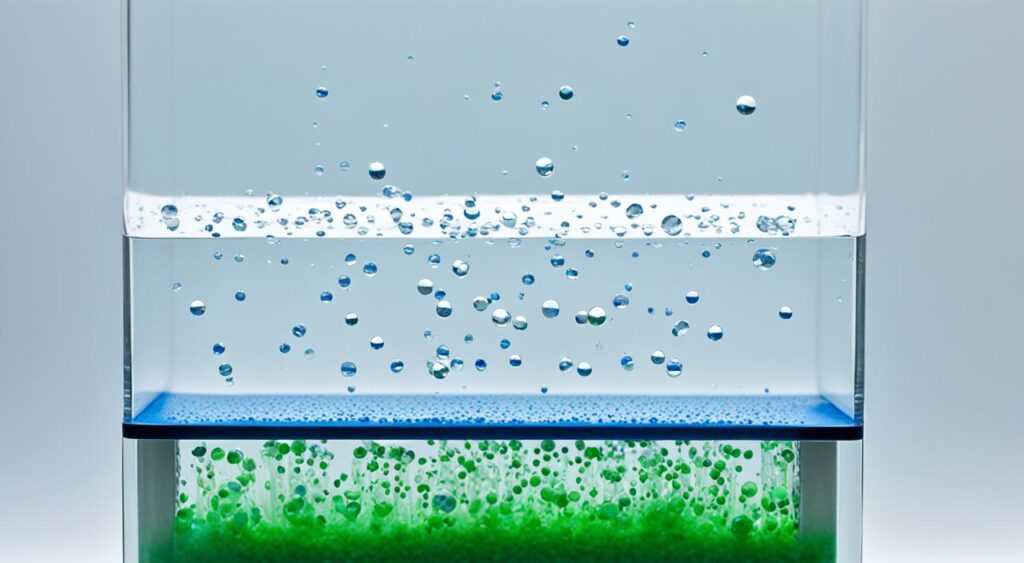
Fluidized bed filters suspend filter media, such as sand or coarse materials, in a water column. As water is pumped through the filter, it creates a fluidized state where the filter media moves and circulates within the column. This continuous movement ensures the filter media remains in contact with the water, maximizing filtration efficiency.
One key advantage of fluidized bed filters is their ability to remove both organic and inorganic waste from the water. The fluidized state allows effective mechanical filtration, trapping small particles and debris. Additionally, the filter media provides a large surface area for beneficial bacteria to colonize, contributing to biological filtration and the breakdown of harmful substances.
Innovative filtration methods like fluidized bed filters offer aquarium owners an efficient and effective way to maintain water quality. By incorporating advanced filtration techniques into their setups, hobbyists can provide a pristine and healthy environment for their aquatic pets.
Power Filters: High-Performance Filtration for Busier Tanks
Power filters are the go-to filtration option when it comes to maintaining a busy aquarium with a high bio-load. These filters are known for their exceptional performance in keeping the water clean and clear, creating a healthy environment for your aquatic companions. Power filters are versatile, efficient, and easy to use, making them popular among aquarium enthusiasts.
Understanding Water Flow Rate and Filter Capacity
Understanding the water flow rate and filter capacity of your power filter is crucial to ensuring effective filtration. The water flow rate refers to the amount of water that passes through the filter within a specific time period. Choosing a power filter with an appropriate water flow rate for your tank size is essential to maintaining optimal filtration.
Filter capacity, however, refers to the amount of water the filter can handle before it needs to be cleaned or replaced. It is crucial to consider the filter capacity as it directly affects the efficiency of the filtration process. A larger filter capacity means the filter can handle a higher volume of water and will require less frequent maintenance.
To determine the ideal water flow rate and filter capacity for your aquarium, consult the manufacturer’s guidelines or seek advice from a knowledgeable professional in the industry.
Customizing Filtration Media in Power Filters for Specific Aquarium Needs
One critical advantage of power filters is their customizable filtration media. These filters allow you to tailor the filtration process to meet the specific needs of your aquarium inhabitants. Whether you have freshwater or saltwater species, power filters offer the flexibility to select the appropriate filtration media, ensuring optimal water quality.
Standard filtration media used in power filters include mechanical, biological, and chemical media. Mechanical media captures debris and particles, biological media provides a large surface area for beneficial bacteria to thrive, and chemical media removes impurities and toxins from the water.
By customizing the filtration media in your power filter, you can address specific concerns such as removing excess waste, enhancing biological filtration, or reducing ammonia levels.
| Filtration Media | Function |
|---|---|
| Mechanical media | Captures debris and particles |
| Biological media | Provides a surface area for beneficial bacteria |
| Chemical media | Removes impurities and toxins |
Integrating Undergravel Filters in Aquatic Ecosystems
Under gravel filters offer a unique and practical approach to maintaining a healthy aquatic ecosystem in aquarium filtration. These filters enhance biological filtration, providing a habitat for beneficial bacteria to thrive and break down waste substances. Integrating under gravel filters into your aquarium setup allows you to create a balanced and self-sustaining environment for your underwater companions.
Enhancing Biological Filtration with an Undergravel Setup
Undergravel filters are installed at the bottom of the aquarium and consist of a perforated plate covered with a layer of gravel. As water flows through the substrate, it oxygenates the gravel bed, promoting the growth of beneficial bacteria. These bacteria establish a colony in the gravel, converting harmful compounds, such as ammonia and nitrite, into less toxic nitrate through nitrification. This natural process helps maintain water quality and keeps the aquarium’s healthy and thriving.
The Esthetics of an Unobtrusive Filtration Option
One notable advantage of under gravel filters is their aesthetic appeal. As the filter plate is hidden beneath a layer of gravel, no external equipment is visible in the aquarium, providing a visually pleasing and unobtrusive filtration option. This makes under-gravel filters an excellent choice for aquarists who prefer a clean and minimalist look in their aquatic displays.
Dive Deeper into the World of Aquarium Filtration
Our journey through the fundamentals of aquarium filters is just the beginning. Delve deeper with us as we explore each facet of aquarium filtration in our upcoming series:
- Types of Aquarium Filters: Discover the diverse world of filters and find the perfect match for your aquatic setup.
- The foundation of Filtration: The Three Pillars of Filtration(Biological, Mechanical and Chemical)
- Aquarium Filter Brands: Navigate the seas of options as we review the top brands in the filtration market.
- Aquarium Filter Accessories: Uncover the essential additions that enhance filtration efficiency and effectiveness.
- Aquarium Filters by Tank Type: Learn how to select the ideal filter for your specific tank type, whether freshwater, marine or a specialized setup.
- Aquarium Filter Setup and Usage: Step-by-step guidance on installing your filter and optimizing its performance.
- Aquarium Filter Maintenance: Keep your aquatic environment pristine with our tips on regular filter care and troubleshooting.
- Aquarium Filter Performance: Evaluate filter performance and ensure your aquatic residents thrive in a clean, healthy environment.
- Specialized Aquarium Filters: Explore filters designed for unique challenges, including breeding tanks and heavily planted aquariums.
- Aquarium Filter Sales: Find the best deals and make informed purchases with our buying tips and recommendations.
- Innovations in Aquarium Filters: Stay ahead of the curve with the latest advancements in filtration technology.
Embark on a Clearer Path to Aquatic Excellence
Your quest for the perfect aquatic ecosystem is a journey we’re excited to share. Each article in our series is designed to illuminate, guide, and inspire. Don’t miss out on turning your aquarium into a thriving, vibrant underwater paradise.

